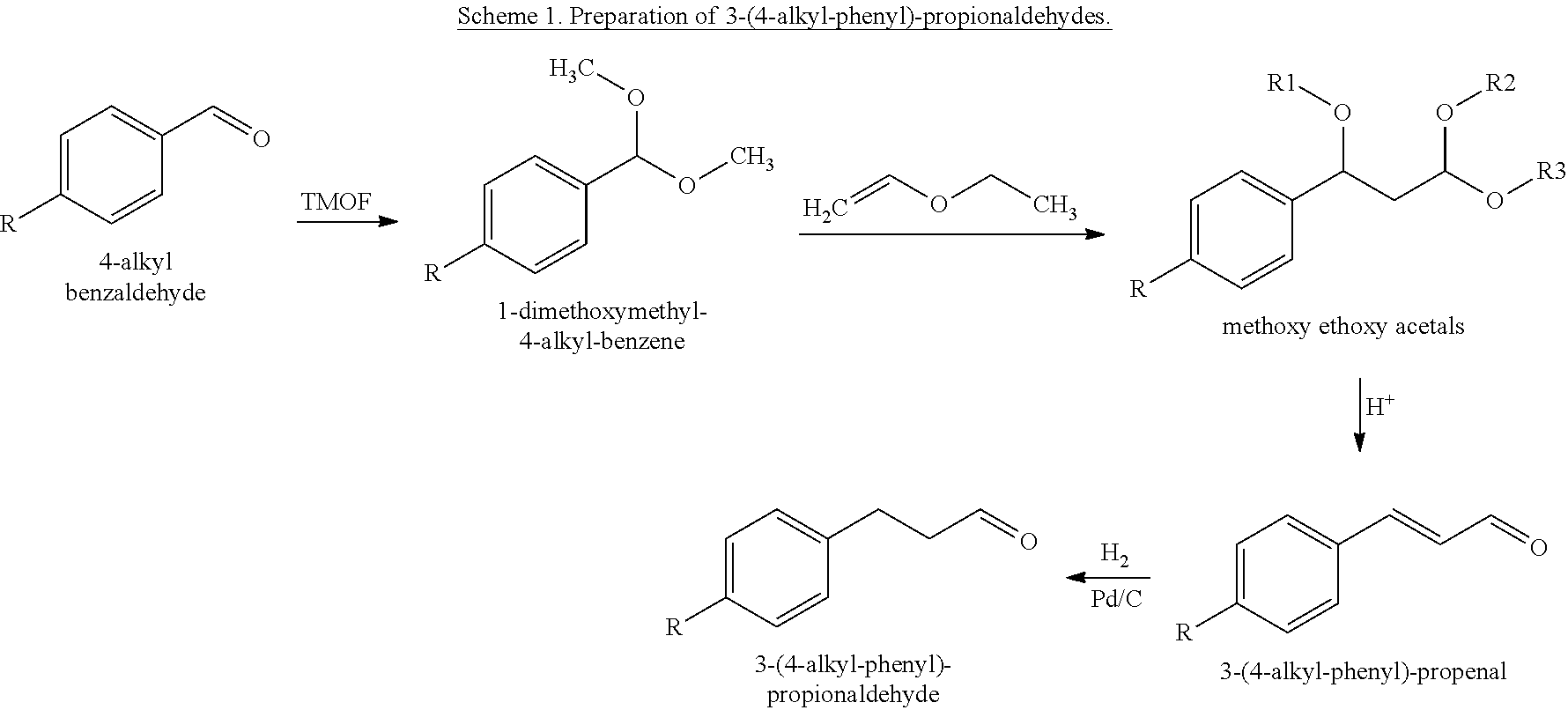Novel 4-alkyl cyclohexanepropanal compounds and their use in perfume compositions
a technology of cyclohexanepropane and compounds, applied in the field of new chemical entities, can solve the problems of difficult identification of desirable fragrance chemicals, difficult for those with skill in the art to predict the effectiveness of a given structure, etc., and achieve the effect of improving, enhancing or modifying a fragrance formulation
- Summary
- Abstract
- Description
- Claims
- Application Information
AI Technical Summary
Benefits of technology
Problems solved by technology
Method used
Image
Examples
example i
[0029]
Preparation of 3-(4-propyl-phenyl)-propionaldehyde: A reaction flask was charged with 4-propyl benzaldehyde (1.064 Kg, commercially available from Mitsubishi Gas Chemical America, Inc.), methanol (500 mL), and trimethyl orthoformate (TMOF) (1.144 Kg, commercially available from Sigma-Aldrich, Inc.). The reaction mass was cooled to −10 to 0° C. and hydrochloric acid (37%, 1 g) was added in one portion. The reaction was instantaneous and the temperature was allowed to rise to 25° C. for over 30 minutes. The reaction mass was then quenched with sodium acetate (20 g) and the solvent was removed by evaporation. The crude intermediate product 1-dimethoxymethyl-4-propyl-benzene (1.388 Kg) was obtained and charged to a second reaction flask at 25° C. Boron trifluride etherate (1 g, commercially available from Sigma-Aldrich, Inc.) was added. Ethyl vinyl ether (684 g, commercially available from Sigma-Aldrich, Inc.) was then fed for over 4 hours with the temperature maintained at 25-30°...
example ii
[0032]
Preparation of 4-propyl cyclohexanepropanal (Formula IV): A reaction flask was charged with 3-(4-propyl-phenyl)-propionaldehyde (240 g, prepared as above), methanol (200 mL), and TMOF (150 g). The reaction mass was cooled to 0° C. and hydrochloric acid (37%, 1 g) was added in one portion. The reaction was exothermic and the temperature rose to 23° C. The reaction mass was quenched with sodium methoxide in methanol (25%, 10 g) and the solvent was removed by evaporation. The crude intermediate product 3-(4-propyl-phenyl)-propionaldehyde dimethylacetal (300 g), 2-propanol (100 mL), and rutheniium on alumina (3 g) were then charged to a 1 L zipper autoclave. The autoclave was purged with nitrogen followed by hydrogen. The autoclave was pressurized with 500 psi hydrogen and heated to 150° C. for 6 hours. The autoclave vessel was then cooled to an ambient temperature, depressurized, and purged with nitrogen. The reaction mass was filtered through celite to remove the catalyst and fu...
example iii
[0035]Preparation of 4-methyl cyclohexanepropanal (Formula II): 4-Methyl cyclohexanepropanal was similarly prepared as described in Examples I and II. First, 4-methyl benzaldehyde (140 g, commercially available from Mitsubishi Gas Chemical America, Inc.) was used to obtain 3-(4-methyl-phenyl)-propionaldehyde (130 g) with a boiling point of 120° C. at a pressure of 21 mmHg 3-(4-Methyl-phenyl)-propionaldehyde (180 g) was consequently used to provide 4-methyl cyclohexanepropanal (104 g) with a boiling point of 112° C. at a pressure of 24 mmHg
[0036]1HNMR: 0.85-0.97 ppm (m, 5H), 1.13-1.73 ppm (m, 10H), 2.40-2.45 ppm (m, 2H), 9.76-9.77 ppm (2s, 1H)
The compound 4-methyl cyclohexanepropanal was described as having strong floral, muguet, and green notes.
PUM
| Property | Measurement | Unit |
|---|---|---|
| weight percent | aaaaa | aaaaa |
| weight percent | aaaaa | aaaaa |
| weight percent | aaaaa | aaaaa |
Abstract
Description
Claims
Application Information
 Login to View More
Login to View More - R&D
- Intellectual Property
- Life Sciences
- Materials
- Tech Scout
- Unparalleled Data Quality
- Higher Quality Content
- 60% Fewer Hallucinations
Browse by: Latest US Patents, China's latest patents, Technical Efficacy Thesaurus, Application Domain, Technology Topic, Popular Technical Reports.
© 2025 PatSnap. All rights reserved.Legal|Privacy policy|Modern Slavery Act Transparency Statement|Sitemap|About US| Contact US: help@patsnap.com



